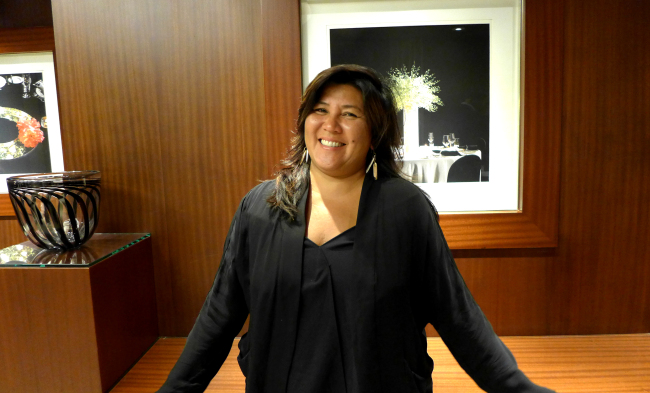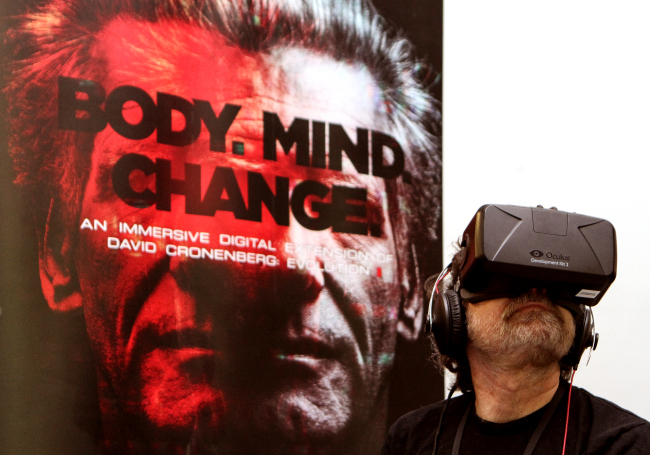 |
The Gothic Bead installation is a co-production by the Art Gallery of Ontario, the Canadian Film Center Media Lab and Seneca College with 3-D scanning led by the AGO’s Lisa Ellis and the VR creative team led by French artist and designer Priam Givord. The medieval Christian sculpture with intricate inner engravings will be exhibited in this fall at the AGO in Toronto. (Ian Lefebvre / Art Gallery of Ontario) |
The work of Ana Serrano, chief digital officer of the Canadian Film Center, involves merging technology and culture together at the cutting edge of the world’s digital transformation wave.
She played a role in reconstructing 3-D images of a gothic bead -- a medieval Christian sculpture with intricate inner engravings -- for an exhibition scheduled for this fall at the Art Gallery of Ontario in Toronto.
Through her creation, people can wear virtual reality glasses to peer into the artifact and experience inside out the ethereal patterns of Middle Ages Christendom.
“This is a perfect example of how culture and technology can work together,” she told The Korea Herald in an interview last week.
“Digital technologies are revolutionizing the entire value chain of our economy. In entertainment, they affect everything from how ideas are created all the way to how films are distributed and televised. My job is to make the film center a digitally forward organization in tune with the tenor of the times.”
 |
Ana Serrano, chief digital officer of the Canadian Film Center (right), poses with Canadian filmmaker and screenwriter David Cronenberg beside an installation she produced that combines digital media storytelling with 3-D printers. (Ana Serrano) |
Serrano came to Korea at the invitation of the Corea Image Communications Institute, which organized the Cultural Communications Forum 2016, an event that gathered the world’s opinion leaders to experience and promote Korean culture.
At the CFC, the Canadian has collaborated with various entertainment giants, including NBCUniversal, jointly launching a multiplatform lab to develop 360 degrees of content with digital technology companies.
In another project called the Astound Initiative, the CFC introduced documentary production agencies to startups and investors to share best practices and create new business models.
“In Canada where most entertainment companies derive their revenues from government funds, we needed to reboot the way these firms are structured and make them sustainable and entrepreneurial,” she said.
The CFC also invests in entertainment startups that invent new technologies and cultivate commercialization strategies, before linking them with global hubs.
“Creating new businesses, products and services -- the innovation component -- has been the focus of my career,” Serrano noted. “It is about anticipating the next generation of storytellers and the digital networking tools they will be.”
 |
Ana Serrano at the Culture Communications Forum 2016 organized by the Corea Image Communications Forum. (Joel Lee / The Korea Herald) |
As part of investment in innovation, the center has produced virtual reality programs and run labs that conduct research on Canada’s VR ecosystem.
The Canadian government has bankrolled the multiplatform content production since the early 2000s, she explained, adding that many have already been fruitful.
Institutions such as the National Film Board of Canada, the National Research Council Canada and Ontario Media Development Corporation provide varied grants, subsidies and tax credits, which have led to wins at the Emmys and Webbys. The Webby Awards honor online excellence in the website space, interactive advertising and digital films and videos.
“Canada is definitely at the cutting edge of digital content development in the world, alongside Australia, UK and France,” Serrano said.
However, the extensive government support has also been a “double-edged sword,” she added, claiming it has allowed firms to hatch new innovations, but discouraged the development of related business models. “Canada as a result lags a little behind in monetizing these innovations.”
With Canada being a highly multicultural society, many of the CFC’s projects have concentrated on ethnic communities. The projects help these groups preserve their traditional culture through digitization and cataloguing services, and make them publicly available and accessible.
The Department of Canadian Heritage also provides longstanding grants to small-sized independent museums and art galleries from coast to coast for digital projects.
 |
A participant wears virtual reality glasses at an exhibition organized by Ana Serrano (Ana Serrano) |
“The younger generations, particularly the millennials, like to get information anytime, anywhere,” she highlighted. “So the challenge is to disseminate the digitized information to them and design the right kind of experiences that involve all five senses.”
Mentioning a visit to the Korea Furniture Museum in Seoul as part of the forum’s itinerary, Serrano said, “It dawned on me that virtual reality still has a long way to go, because it doesn’t engage all five senses as in a real setting.”
“But it’s not far off, we will get there sooner than we think. These digital technologies will transport us to back to our history that we can’t otherwise conceive or experience,” she added.
Regarding Korea’s role in harmonizing its culture and technology, she argued that Korea could converge its high-tech prowess and traditional culture, much as it has commercialized its K-pop, TV dramas, fashion and cosmetics.
“Right now, this does not seem to be the core of Korea’s cultural branding strategy,” she remarked.
By Joel Lee (
joel@heraldcorp.com)











